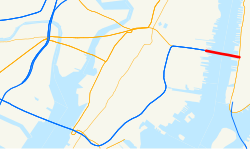
Back Тунэль Холанда Byelorussian Tunel sa Holland CEB Hollandův tunel Czech Hollandtunnelen Danish Holland Tunnel German Tunelo Holland Esperanto Túnel Holland Spanish Holland Tunnel Estonian Holland tunela Basque Holland Tunnel French
 Eastbound in the Holland Tunnel in December 2019 | |
| Overview | |
|---|---|
| Other name(s) | Holland Vehicular Tunnel Hudson River Vehicular Tunnel Canal Street Tunnel |
| Location | Jersey City, New Jersey–Lower Manhattan, New York City |
| Route | |
| Crosses | Hudson River |
| Operation | |
| Opened | November 13, 1927 |
| Operator | Port Authority of New York and New Jersey |
| Toll | (Eastbound only) As of January 7, 2024:
|
| Vehicles per day | 89,792 (2016)[2] |
| Technical | |
| Length | 8,558 feet (2,608.5 m) (westbound) 8,371 feet (2,551.5 m) (eastbound) |
| No. of lanes | 4 |
| Tunnel clearance | 12.6 feet (3.84 m) |
| Width | 20 feet (6.1 m) |
| Depth of tunnel below water level | 93 feet (28.3 m) below MHW |
| Route map | |
 | |
Holland Tunnel | |
Video of an eastbound trip through the tunnel | |
| Location | Jersey City, New Jersey and Lower Manhattan, New York City |
| Built | 1920 |
| Architect | Clifford Holland |
| NRHP reference No. | 93001619 |
| NYSRHP No. | 06101.007028 |
| Significant dates | |
| Added to NRHP | November 4, 1993[3] |
| Designated NHL | November 4, 1993 |
| Designated NYSRHP | November 4, 1993 |
The Holland Tunnel is a vehicular tunnel under the Hudson River that connects Hudson Square and Lower Manhattan in New York City in the east to Jersey City, New Jersey in the west. The tunnel is operated by the Port Authority of New York and New Jersey and carries Interstate 78. The New Jersey side of the tunnel is the eastern terminus of New Jersey Route 139. The Holland Tunnel is one of three vehicular crossings between Manhattan and New Jersey; the two others are the Lincoln Tunnel and George Washington Bridge.
Plans for a fixed vehicular crossing over the Hudson River were first devised in 1906. However, disagreements prolonged the planning process until 1919, when it was decided to build a tunnel under the river. Construction of the Holland Tunnel started in 1920, and it opened in 1927. At the time of its opening, it was the longest continuous underwater tunnel for vehicular traffic in the world.
The Holland Tunnel was the world's first mechanically ventilated tunnel. Its ventilation system was designed by Ole Singstad, who oversaw the tunnel's completion. Original names considered for the tunnel included Hudson River Vehicular Tunnel and Canal Street Tunnel, but it was ultimately named the Holland Tunnel in memory of Clifford Milburn Holland, its initial chief engineer who died suddenly in 1924 prior to the tunnel's opening.